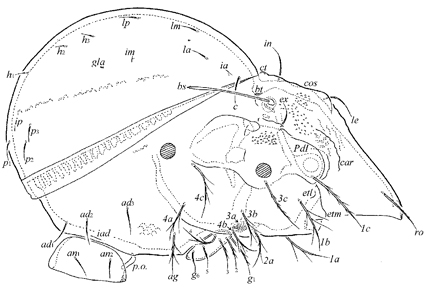Abstract
The oribatid mite family Sternoppiidae is recorded in Peru for the first time. A new subgenus and three new species of Sternoppia—Sternoppia (Andoppia) subgen. nov., S. (A.) tetratuberculata sp. nov., S. (Sternoppia) chinchaoensis sp. nov., and S. (S.) americaensis sp. nov.—are described, based on materials collected from upper soil and leaf litter in mountain forests in the Andes. Generic diagnosis, identification key, distribution and habitats of representatives of Sternoppia are presented.
References
Balogh, J. & Balogh, P. (2002) Identification keys to the oribatid mites of the Extra-Holarctic regions. Vols. 1 & 2. Well-Press Publishing Limited, Miskolc, 453 pp. & 504 pp.
Balogh, J. & Mahunka, S. (1968) The scientific results of the Hungarian soil zoological expeditions to South America. 5. Acari: Data to the oribatid fauna of the environment of Córdoba, Argentina. Opuscula Zoologica Budapest, 8 (2), 317–340.
Balogh, J. & Mahunka, S. (1969a) The scientific results of the Hungarian soil zoological expeditions to South America. 10. Acari: Oribatids, collected by the second expedition. I. Acta Zoologica Academiae Scientiarum Hungaricae, 15 (1–2), 1–21.
Balogh, J. & Mahunka, S. (1969b) The zoological results of the Hungarian soil zoological expeditions to South America. 11. Acari: oribatids from the material of the second expedition, II. Opuscula Zoologica Budapest, 9 (1), 31–69.
Balogh, J. & Mahunka, S. (1977) New data to the knowledge of the oribatid fauna of Neogaea (Acari). I. Acta Zoologica Academiae Scientiarum Hungaricae, 23 (1–2), 1–28.
Balogh, J. & Mahunka, S. (1978) New data to the knowledge of the oribatid fauna of the Neogea (Acari). III. Acta Zoologica Academiae Scientiarum Hungaricae, 24 (3–4), 269–299.
Balogh, J. & Mahunka, S. (1979) New data to the knowledge of the oribatid fauna of the Neogaea (Acari). IV. Acta Zoologica Academiae Scientiarum Hungaricae, 25 (1–2), 35–60.
Balogh, J. & Mahunka, S. (1980) New data to the knowledge of the oribatid fauna of the Neogaea (Acari). V. Acta Zoologica Academiae Scientiarum Hungaricae, 26 (1–3), 21–59.
Ermilov, S.G., Sandmann, D., Marian, F. & Maraun, M. (2013) Three new species of the genus Sternoppia (Acari: Oribatida: Sternoppiidae) from Ecuador. Zootaxa, 3641 (5), 565–576. https://doi.org/10.11646/zootaxa.3641.5.5
Franklin, E. & Woas, S. (1992) Some basic oppiid-like taxa (Acari, Oribatei) from Amazonia. Andrias, 9, 57–74.
Franklin, E., Hayek, T., Fagundes, E.P. & Silva, L.L. (2004) Oribatid mite (Acari: Oribatida) contribution to decomposition dynamic of leaf litter in primary forest, second growth, and polyculture in Central Amazon. Brazilian Journal of Biology, 64 (1), 59–72. https://doi.org/10.1590/S1519-69842004000100008
Franklin, E., Santos, E.M.R. & Albuquerque, I.C. (2006) Diversity and distribution of oribatid mites (Acari: Oribatida) in a lowland rain forest in Peru and in several environments of the Brazilians states of Amazonas, Rondônia, Roraima and Pará. Brazilian Journal of Biology, 66 (4), 999–1020. https://doi.org/10.1590/S1519-69842006000600007
Illig, J., Sandmann, D., Schatz, H., Scheu, S. & Maraun, M. (2007) Checklist Reserva Biólogica San Francisco (Prov. Zamora-Chinchipe, S. Ecuador). Ecotropical Monographs, 4, 221–230.
Mahunka, S. (1983) Neue und interessante Milben aus dem Genfer Museum XLVII. Oribatida Americana 7: Guatemala II. Revue suisse de Zoologie, 90 (3), 709–724. https://doi.org/10.5962/bhl.part.82009
Mahunka, S. (2006) Oribatid mites (Acari, Oribatida) from Venezuela. II. New or rare species from montane forests. Acta Zoologica Hungarica, 52 (3), 271–286.
Norton, R.A. (1977) A review of F. Grandjean's system of leg-chaetotaxy in the Oribatei and its application to the Damaeidae. In: Dindal, D.L. (Ed.), Biology of Oribatid Mites. State University of New York, Syracuse, New York, pp. 33–62.
Norton, R.A. & Behan-Pelletier, V.M. (2009) Suborder Oribatida. In: Krantz, G.W. & Walter, D.E. (Eds.), A Manual of Acarology. Texas Tech University Press, Lubbock, Texas, pp. 430–564.
Subías, L.S. (2022) Listado sistemático, sinonímico y biogeográfico de los ácaros oribátidos (Acariformes: Oribatida) del mundo (excepto fósiles). Monografías Electrónicas S.E.A., 12, 1–538.
Subías, L.S. & Balogh, P. (1989) Identification keys to the genera of Oppiidae Grandjean, 1951 (Acari: Oribatei). Acta Zoologica Hungarica, 35 (3–4), 355–412.
Subias, L.S., Zaballos, J.P., Banda, E., Fontal-Cazalla, F. & Nieves-Aldrey, J.L. (2004) Ácaros oribátidos (Acari, Oribatei) del Parque Nacional de la isla de Coiba, Panamá. Revista de Biología Tropical, 52 (1), 85–95. https://doi.org/10.15517/rbt.v52i1.14755
Travé, J. & Vachon, M. (1975) François Grandjean, 1882-1975 (Notice biographique et bibliographique). Acarologia, 17 (1), 1–19.


